Modernism In Kiew
With only three hours to spare, Evan Panagopoulos rushed through Kiev’s complex Socialist Modernist architecture and 20th century history last winter. This is the account of his brief emotional journey in the Ukrainian capital.

The former Institute of Scientific, Technical and Economic Information in Kiev.
As the chilling wind numbed my face on that cold February morning, I accepted that Kiev was no small town by any measure. I found it to be a gritty and often overwhelming modern metropolis that would keep challenging me. There’s nothing more attractive than a city full of opportunities to push boundaries and ask questions.
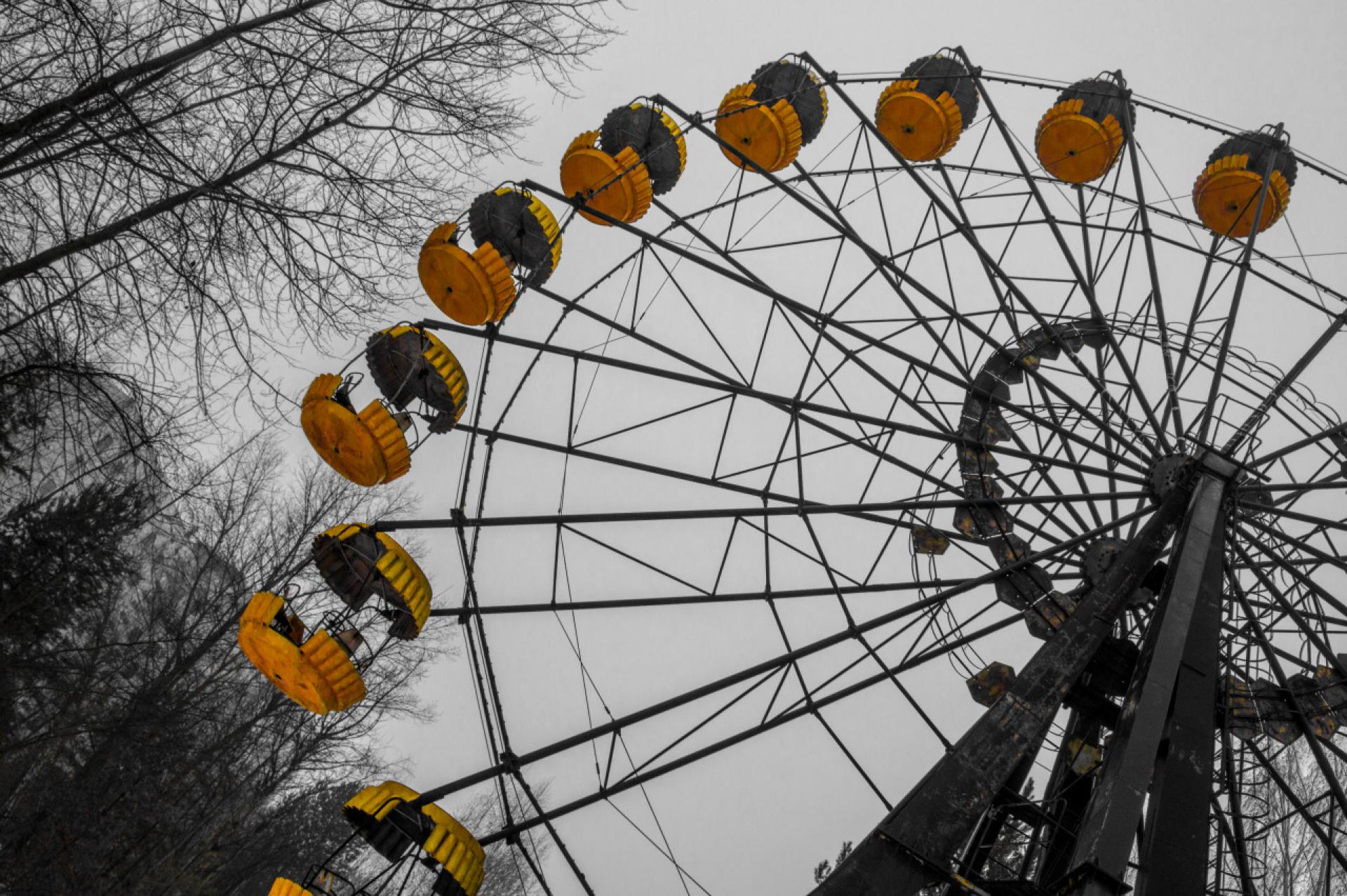
The ghostly ferris wheel in Pripyat.
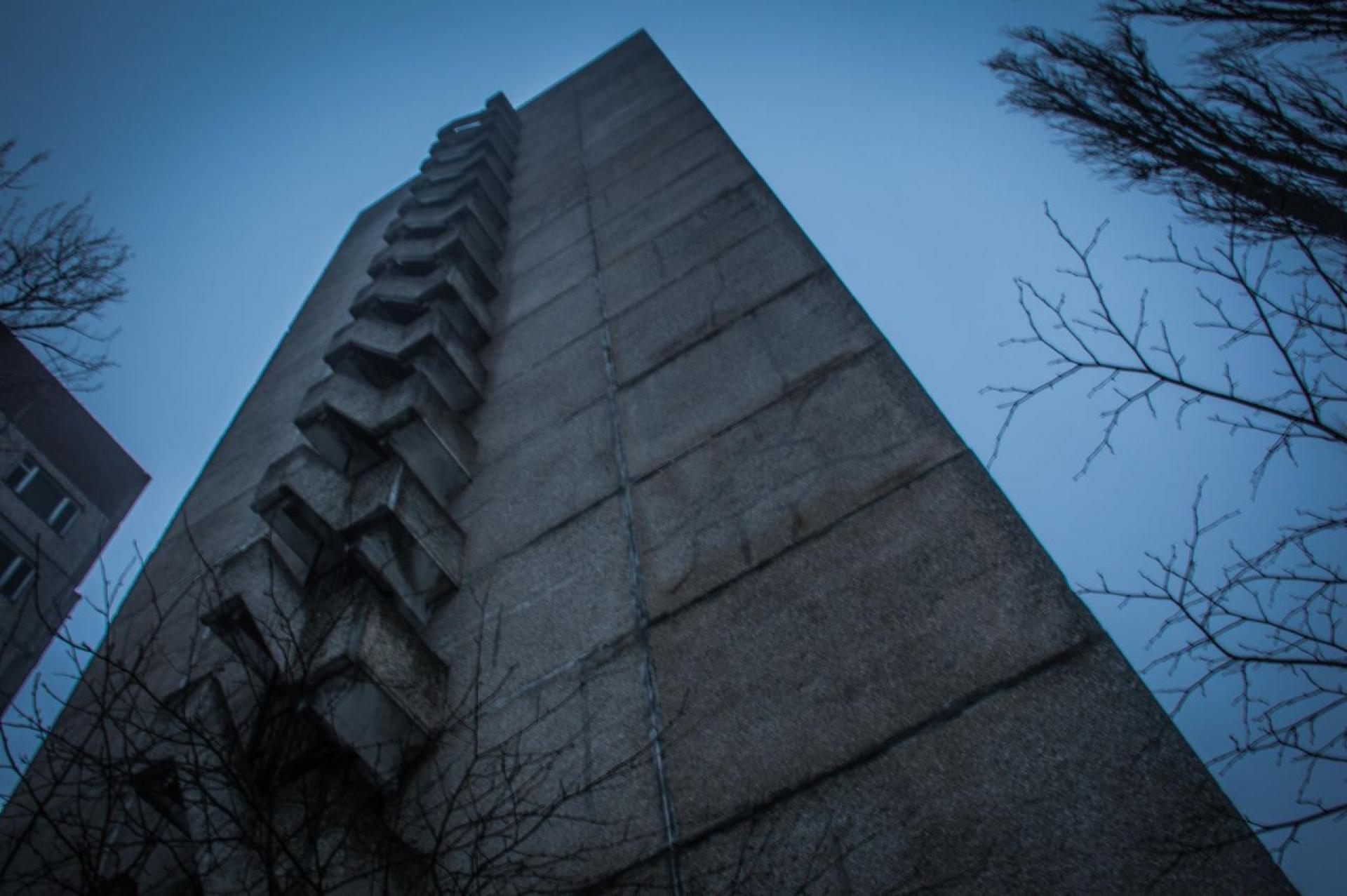
Dwellers abandoned the buildings in Pripyat.
It made perfect sense to invest most of my winter’s daylight inside the Chernobyl Exclusion Zone, that was the plan. The overarching purpose of my trip to the Ukraine was to experience the abandoned magnificence of Pripyat. My visit to the irradiated ghost town was a humbling experience: it’s a testament to man’s occasional failure to command nature.
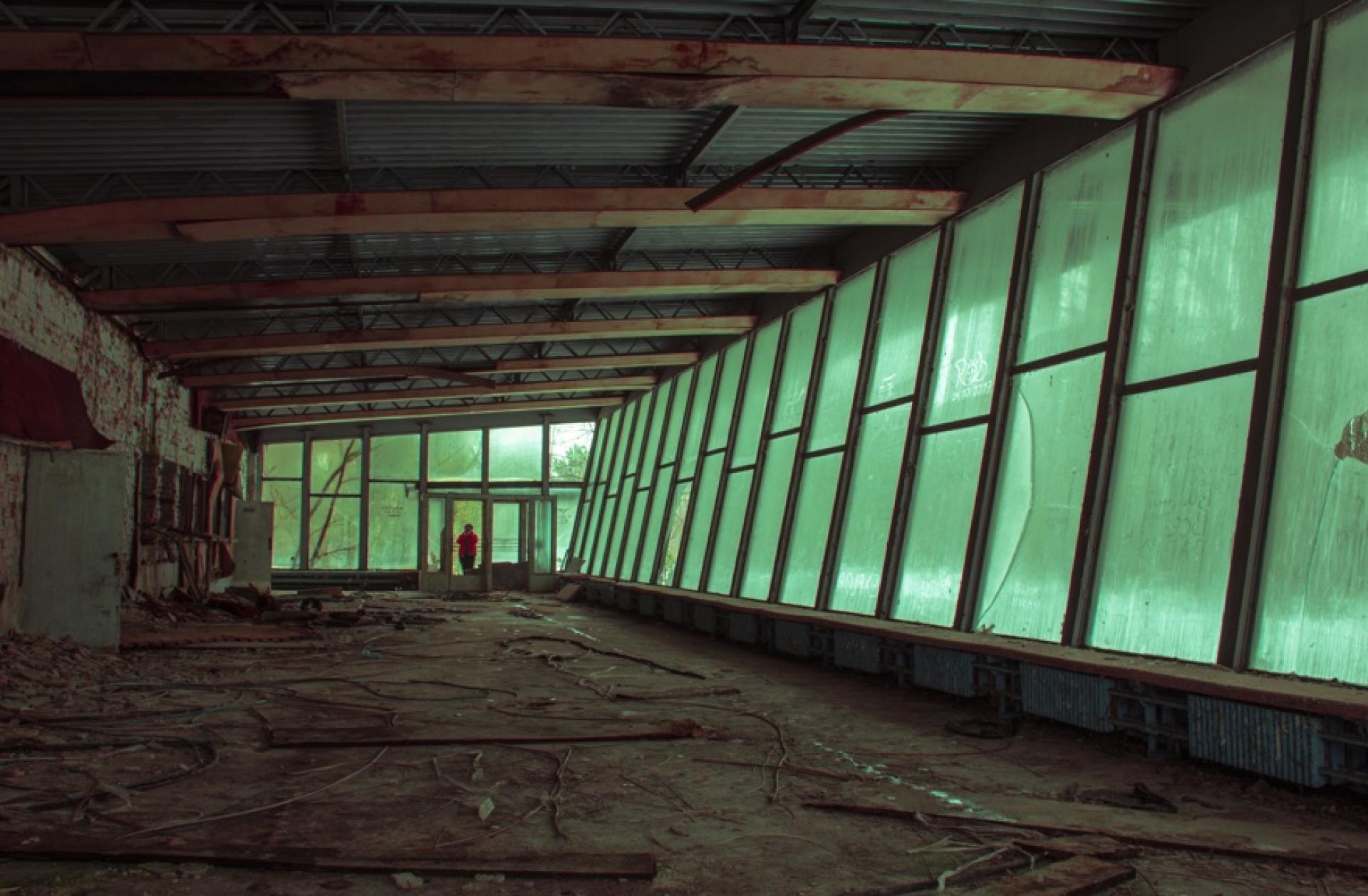
The abandoned coach station in Pripyat.
But Kiev, which I’d mostly seen through fogged car windows and the sine-qua-non short stroll down the nearest pub, hadn’t ceased beckoning to me from the background. I thought that I’d never forgive myself if I’d miss out on an opportunity to record its extraordinary architecture, and perhaps get a cursory glimpse of its complex past and present along the way.
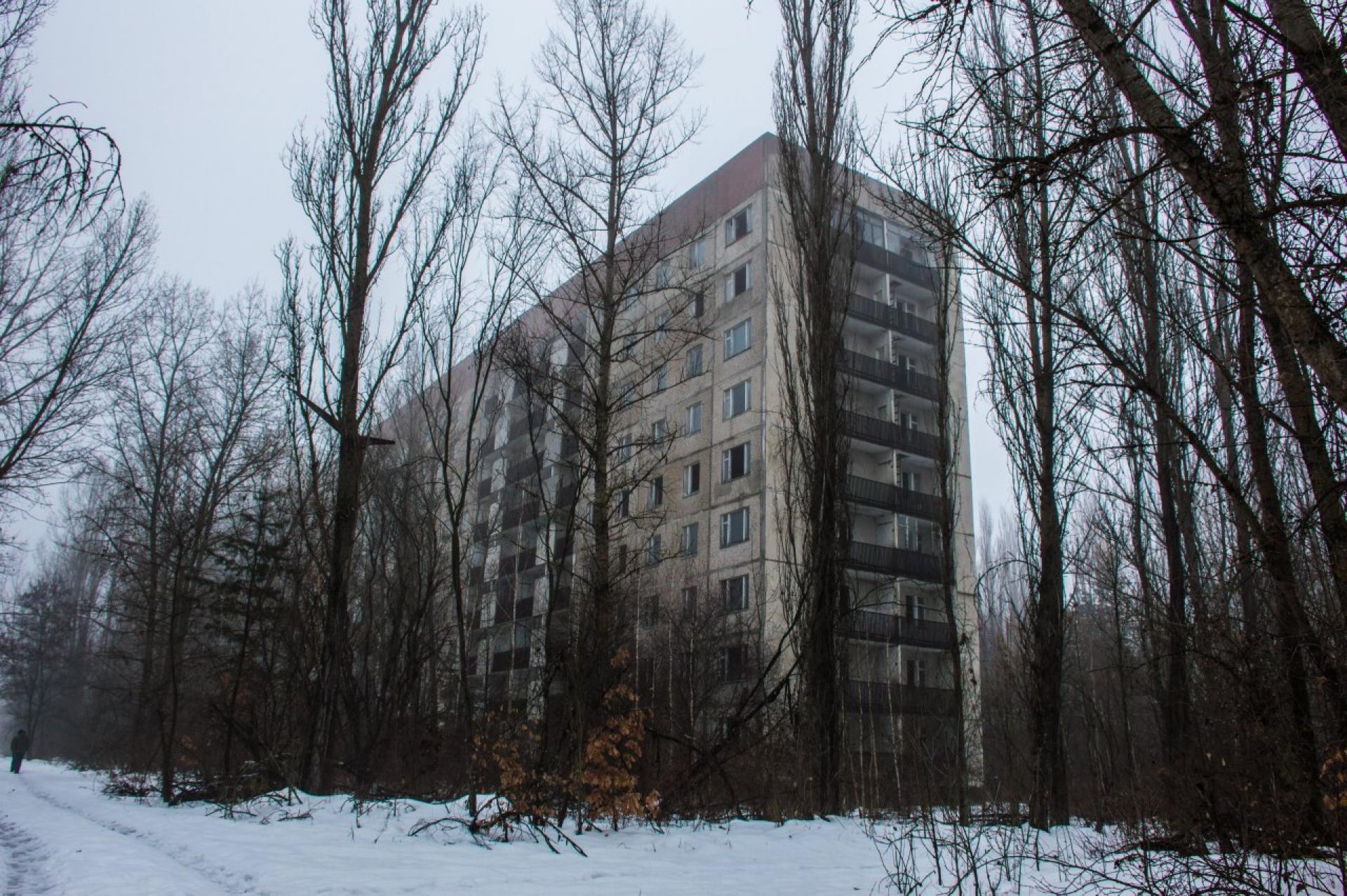
A vacant apartment block in Pripyat.
I have neither time nor energy left at the point where I commit to rush through Kiev. I’d already spent an incredible 4 days in the Exclusion Zone, ploughing through deep, knee high snow and dodging radiation hot spots. I’d endured freezing temperatures, scaled rusty Soviet radars, and explored crumbling factories and high rises. My body had been screaming for a rest on the long way back to Kiev, but I wasn’t prepared to make an excuse yet: despite having to catch an early afternoon flight next day, I remained determined to see as much of Kiev as I could squeeze into what little time I had left.

The hotel Salyut was built in 1984 by the late Avram Miletsky, the most celebrated son of Kyiv when it comes to Socialist Modernist architecture.
It’s 06.30 in the morning as I venture outside. The fog is thick, the temperature is sub-zero, my body is aching, and as the cold wind hits me, I’m questioning my sanity. A few nights before, I found myself trapped for over an hour inside a cab, stuck in one of Kiev’s frequent gridlocks: a contingent of angry young men in military fatigues, brandishing torches and black flags had blocked the entire downtown, marching the streets in protest. Helplessly stuck in traffic, I had plenty of time to ponder the many complexities of Kiev: An entire city unable to commute. An entire nation unable to move on. Stuck in a post-Soviet impasse, the enduring clash between Ukraine’s European aspirations and its many dependencies with Russia has had the country grinding to a halt. Caught in the political crossfire of a simmering state of war, many Ukrainians choose to escape via the obvious side streets: call it ultra-nationalism, call it even worse. But who but the luckiest ever got home faster by venturing into the side streets in a standstill? One of us decides to get out of the taxi and walk. He’ll probably make it home before the rest of us. The smart, decisive minority – it’s always there. I’m hoping there’s one for Ukraine too.

The outdoor terrace of the Palace of Pioneers was destroyed in 2000. | Photo via © Edvard Bilsky
I knew I wouldn’t be able to see everything I wanted, so starting location matters. I was lucky to have been repairing at the Hotel Salyut the night before, since it is an agreeable Socialist Modernist marvel, and a well-regarded landmark. It was built in 1984 by the late Avram Miletsky, the most celebrated son of Kyiv when it comes to Socialist Modernist architecture, and it’s incredibly easy to scratch that itch by simply staying the night there. I am standing outside it now, the streets are empty, and it’s dark, foggy and bitterly cold. But it’s definitely worth it: there’s not a living soul around, and here I am, enjoying an exclusive, unobstructed view of Salyut’s modernist majesty as my reward. As it is often the case with visionary architecture, the original, unrealized design was supposed to be a sky scraping three times taller, but funding problems and political bickering meant that the resulting building eventually fell short of Miletsky’s original ambition.
Next to the hotel, Avram Miletsky created together with Edward Bilsky the Palace of Pioneers, another Socialist Modernist gem. The Palace was a place for learning and creative pastime, and consequently also a center for the indoctrination of Soviet youth to communist ideals. These ideals had been transliterated to its internal and external architectural language, through Socialist Realist murals, and Futurist spaces and flourishes.
Today, the Palace is retaining this educational character as Kiev’s Palace of Children and Youth. But despite the sensibility of utilizing the space according to its original function, an unfortunate clash with Ukraine’s new character persists. I’ve heard that the government is determined to further alter its utilization, and is seeking to turn it into a business or conference center. This kind of forcible interrupt with the past is a common manifestation of the post-Soviet conundrum of Eastern European democracies. Buildings perceived as carrying a stigma are being alienated, rather than given a chance to assimilate. Could they ever commit to enhance architectural function and memory in a constructive way, rather than seeking to disrupt it?
I have to make the hard choice to move on and postpone the Palace visit for another time, not least because it's daybreak, and it’ll be another 2 hours before it even opens. But just across the road from Salyut and the former Palace of Pioneers, one can find the entrance to the Memorial Park of Eternal Glory, dedicated to the victory over the Nazis and built during the late 1950’s, although a memorial space existed here since 1894. Its imposing 26 m obelisk is approached through a path lined with the graves of 34 Heroes of the Soviet Union. The Eternal Flame honoring the Unknown Soldier at the base of the obelisk was reportedly lit at its inauguration in 1957 with light brought in from the Eternal Flame at the Mamaev Kurgan Monument in Stalingrad.

Commanding attention : The Memorial of Eternal Glory
The adoptive Soviet narrative of the monument has so far eluded the effects of Ukraine’s strict decommunization laws, since all WW II related monuments fall short of its scope. It is after all, a monument commemorating the struggle of Ukrainians against invaders, but it’s also very much a Red Army memorial. Therefore, it’s a space that divides public opinion in Kiev. But it’s also a monument that commands attention, and perhaps can be received in a less politicized way: military monuments can be about how men die, and not necessarily about why.

The Memorial Park has been expanded beyond the Eternal Glory obelisk to include the Monument to the Great Famine known as the Holodomor. It is a result of misguided Soviet economic policies of the time. It resulted to a catastrophic loss of life: millions of Ukrainians starved to death, marking one of the darkest pages in the history of the country. It is a desperate, haunting space, heavy with symbolism.
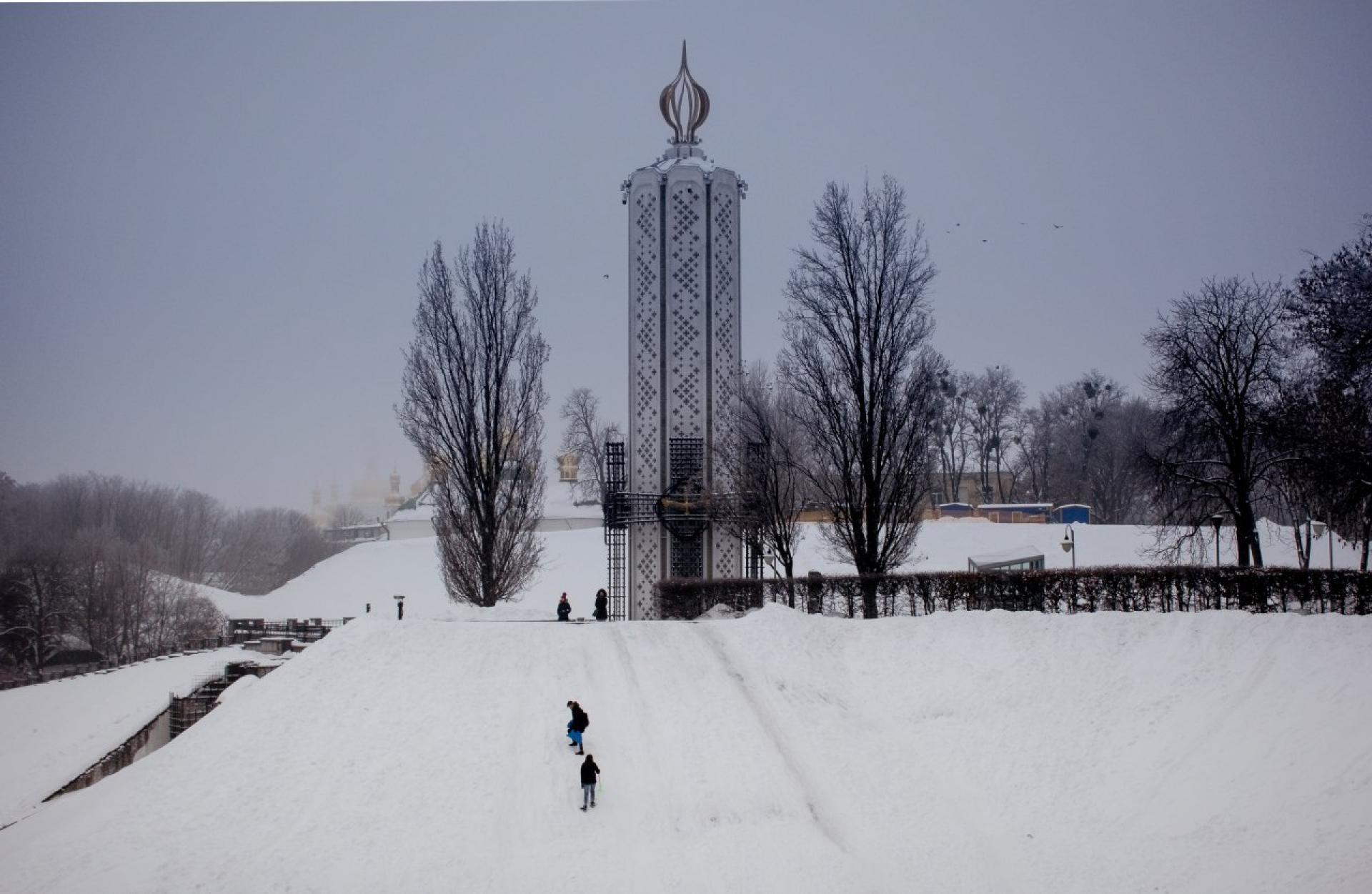
The Candle of Memory at the Holodomor Monument
This is an overwhelming location. This is where I feel compelled to ask why. For me, memorials to men, women and children as victims of ideology evoke the most powerful of emotions. I see these as spaces enabling us to pass judgement, and I find it meaningful to erect this counter-memorial to those who suffered as a result of Soviet callousness, so close to another seen to exalt Soviet military prowess. It is such contrast that stimulates thought and provides us with critical responses to events through a visual narrative. In my mind this approach is superior to re-purposing monuments, and definitely better than destroying these while attempting to relate a historic account.
But the clock is ticking, and I have to keep pushing on towards the prize asset: it’s the astonishing Motherland monument. This is surely the pièce de résistance when it comes to monumental architecture in Kiev. But between the Holodomor monument and the Mother, one encounters the sprawling religious complex of Pechersk Lavra, with its golden domed cathedrals and monasteries. An important piece of advice here: if you’re aiming to get straight to the Motherland Monument, don’t go through the Lavra. Trying to reach her as the crow flies is just the wrong way to go, as I had already found on my first day in Kiev.

And speaking of crows, there are literally thousands of them perching on the trees surrounding the Lavra. Their sight is mesmerising, although I should have listened to their ominous cawing and changed direction earlier. Instead, I ended up spending an inordinate amount of time trying to grind my way through the monasteries without result. The many nooks and crannies, steep slopes and dead ends had me hopelessly lost, stuck in a cemetery next to its wall without a visible through exit to the Mother.

I was better prepared on that Sunday morning, and quickly powered my way past the churches, toward the entrance to the War Museum. Immediately past the Lavra, the open spaces on either side of the grand pathway toward its main entrance are lined with all sorts of equipment: tanks, warplanes, artillery, even a mobile ICBM launcher. It hurts me to have to rush past this uniquely interesting collection of materiel in a hurry, but I have to stick to my commitment, I am now aware that over an hour has already flown by.
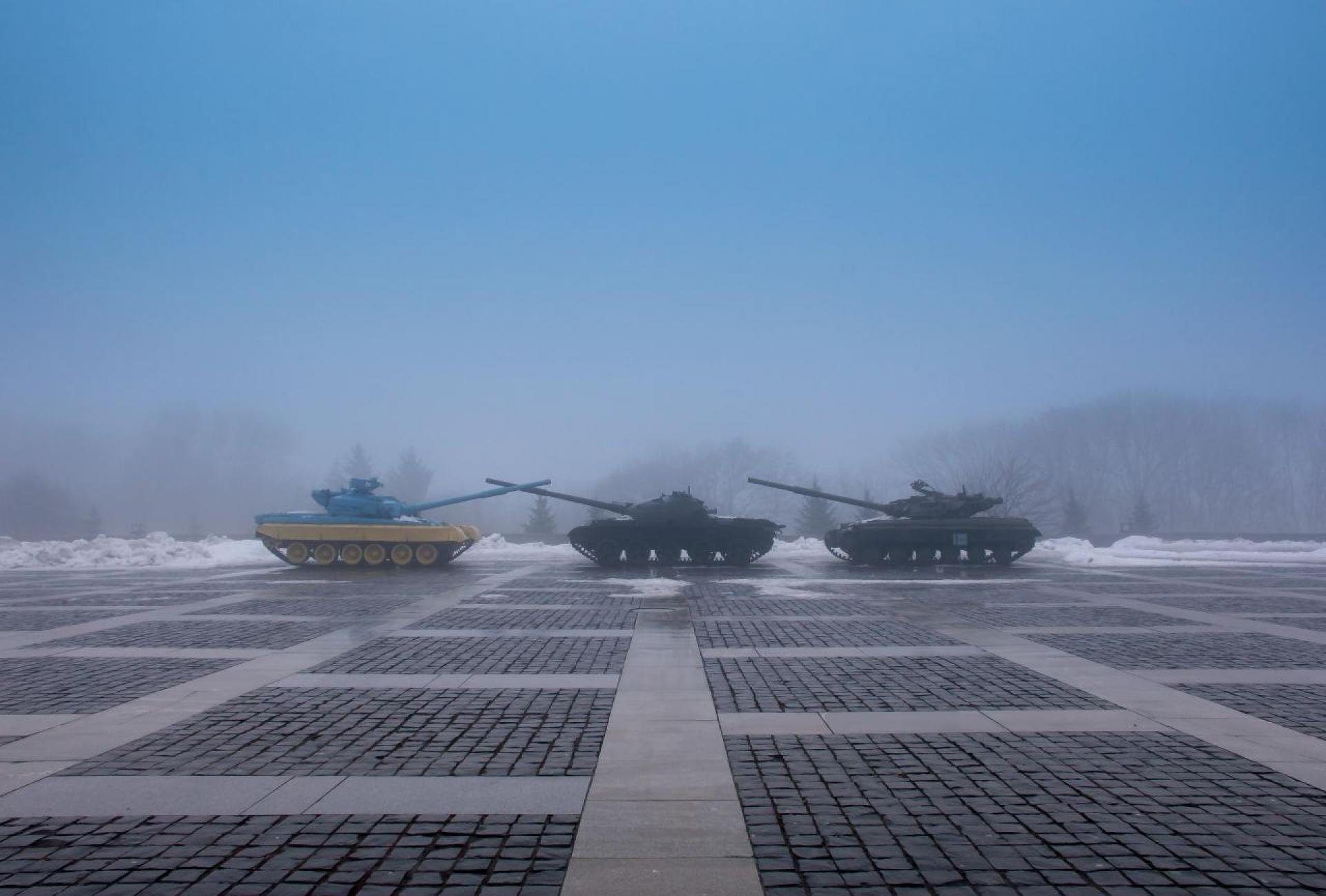
Tanks in the courtyard of the War Museum
But the curse of the crows had not worn out yet. Kiev can become extremely foggy, especially in the early hours of the morning. It makes for intense atmosphere and great photography, but it also means that visibility is extremely low. You might have guessed it already: despite my best efforts, I found the Mother of Ukraine shrouded in thick fog. So thick, that not even the base of the statue was visible from the entrance of the museum she’s standing atop. All I could make was the blurry outline of her monumental proportions as she remained obscured into the cold, milky atmosphere. Taking into account my previous failed attempt, this was the second time we have been prevented from acquaintance. It’s was exasperating.
Despite my disappointment over this part-failed interaction, not everything is lost. The cavernous main entrance to the War Museum is a satisfying combination of well poured concrete and Socialist Realist reliefs portraying the Red Army in combat. The piece closest to the museum stands out: an evocative statue of troops crossing the Dnieper to liberate Kiev in 1943. The lingering fog adds volumes to the heroic character of this ensemble, bringing it to life: there’s already an inherent fluidity in the sculpture, and looking at it through the blur, the bodies, limbs and firearms of the soldiers appear to be in motion, rendered in epic proportion. It is a visceral scene, engaging the viewer at a primal level. It’s so alive, to the point it emanates presence, and therefore its very existence elicits disapproval among locals. The daily encounter with powerful Soviet art still stimulates a fight or flight response to the trauma, or danger it can be considered to represent for Ukrainians today.

Crossing the Dnieper; an evocative socialist realist monument.
My thoughts are arrested as I am gripped by frost, and time is running out. I hop on a taxi to rush towards my next stop. I find it hard to explain where I want to go to the taxi driver: He’s not aware of an Institute of Scientific and Technical Information, a flying saucer. It is a sign of the changing times: an impressively Modernist cultural centre overshadowed by a non-descript temple of consumerism in the collective short term memory of those who claim the knowledge of the city.
It was conceived by Florian Yuryev, a controversial painter, composer and architect. In the mid 1950’s he developed a new art theory revolving around the phenomenon of Synesthesia, in particular about the sensory perception of sound through colors. To that end, he created an experimental light and music orchestra, and imagined a suitable auditorium equipped with a system of light and sound transmission for the realisation of his art project.

Kyiv’s Flying Saucer was an experimental space. | Photo © Alex Moore
I am not certain as to the point when the ensemble was named The Institute of Scientific and Technical Information, but rumour has it that the KGB sponsored its construction, allowing Yuryev to deploy his futuristic design. Could they see a potential military or intelligence application in his art project? It’s difficult to tell, although I like this theory. It is known that the auditorium was eventually used as the Institute’s cinema and lecture hall, which means that the original Synesthesia project might have expired, or maybe axed by the powers that be at some point. As the cranes of yet another shopping mall rise ominously behind it, the now boarded up Institute awaits its new fate. It said that it may be turned into one of the malls entrances, even demolished. It would be a harrowing fate for the site of such an ambitious and futuristic project.

A stream of early Sunday shoppers are crowding the mall already. They appear somewhat indifferent to the Flying Saucer, and more intent to the discount shopping opportunities on offer. I hardly have one hour left, and I feel like lamenting this impending loss. I hop on another taxi and make my way to the nearby Memory Park, inside Kiev’s main cemetery. It is yet another complex space, and the result of a precarious balance between the architect Avram Miletsky, and the artists Ada Rybachuk and Vladimir Melnichenko. Although Miletsky is usually credited with the photogenic Crematorium masterpiece atop the Balkova Hill, it was Rybachuk and Melnichenko who were involved in conceptualising the space as a landscaped Memory Park, including features like the Wall of Memory, a now defunct relief aiming to soothe mourners through the use of a visual art narrative. The Wall of Memory took almost 10 years to accomplish, but was concreted over in 1982 at the orders of the Communist Party leadership. I am not aware of the reasons, but can’t help thinking that this is a great excuse for today’s government to do their utmost to uncover it. I notice the massive head of a statue protruding through the concrete shroud: I’ve never hoped for cement to be so brittle as in the case of the Wall of Memory.
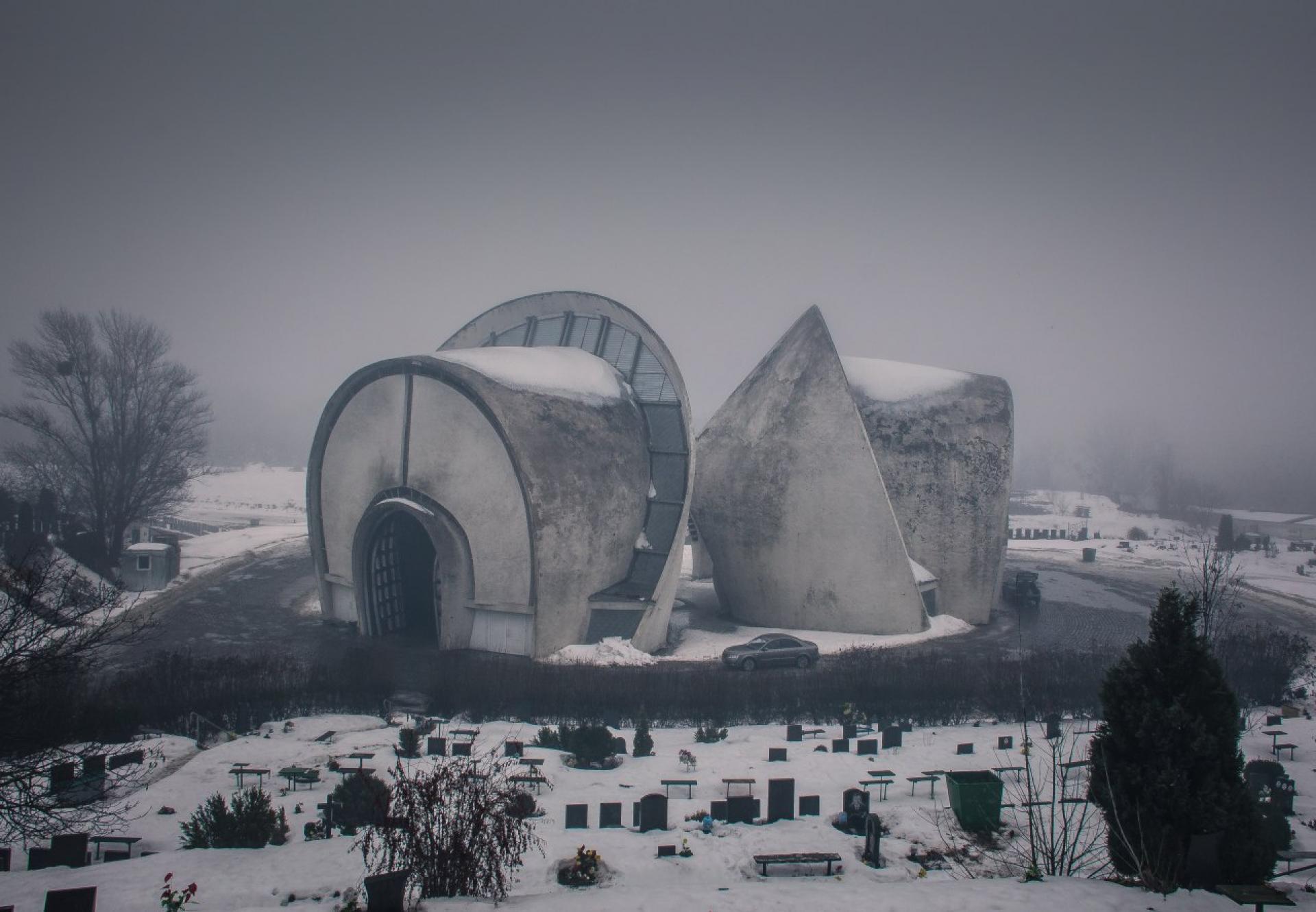
Death is only the beginning at the crematorium.
Cremation as a funerary solution was not a popular concept in post-war Ukraine. With memories of the horrific massacres at nearby Babi Yar still vivid, public opinion had been apprehensive towards the idea of creating a place for the ceremonial incineration of bodies in Kyiv. This must have been an emotional journey for Avram Miletsky too, a man of Jewish heritage. I can witness a tidal wave of this emotion in the flowing shapes of his Crematorium, built in the mid 70’s. It is a poignant building designed to provide visual succour, and I discover it to almost be like a gateway to another, better world. When seen contextually within the greater Memory Park and Wall of Memory concept, the entire ensemble functions as a space for healing and contemplation, something like a departure station to a mystical final destination. This reminds me that Miletsky, Rybachuk and Melnichenko were actually involved in the building of another modernist departure terminal before: the Kyiv Central Bus Station which is very close to the cemetery
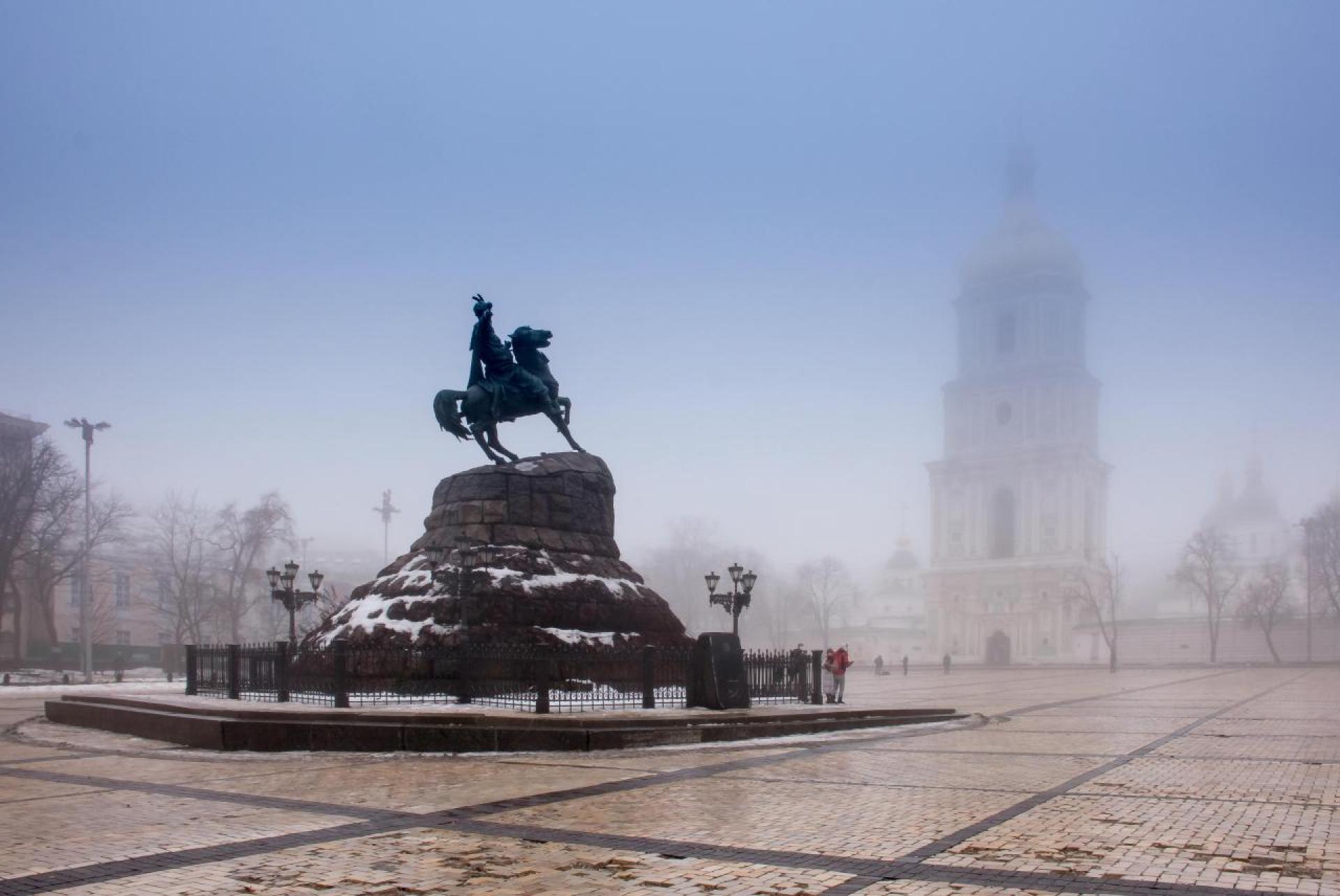
Hetman Bohdan Khmelnitsky at Sophia Square.
But it is with regret that I realise that I have ran out of time and I won’t be able to visit the Central Bus Terminal. My last stop is Kiev’s central Sophia Square, dominated by the historic Cathedral of Saint Sophia, and the statue of the Cossack Hetman (Chief) Bohdan Khmelnitsky from 1888. I take a few moments to think about the important context of this space. It is one of the oldest parts of Kiev, with significant connections to Ukrainian heritage and independence, not least the monument of Khmelnitsky, the creator of the first independent Ukrainian Cossack state, and for many the founding father of Ukraine.
Despite its direct links with Ukrainian national identity, this is a statue whose existence had once been encouraged by the Czar of Russia, funded by Russian public subscription, and cast at a foundry in St.Petersburg. And despite its nationalist character, the statue seems to have survived Soviet times: Khmelnitsky had sponsored the eventual union of his Hetmanate with Imperial Russia, so that might have been an excuse for its preservation. Can similar excuses still be made in the course of preserving Kiev’s significant ex-Soviet heritage? I think there is space for that, and even offered some perspective on how this might happen. The fog becomes Kiev, but I have great expectations for much clearer skies next time I visit.
Text and photos (unless stated otherwise) by Evan Panagopoulos.

Evan Panagopoulos is the urban storyteller behind the alternative travel site explorabilia and the Abandoned Sector blog. He’s an avid fan of brutalist and mid-century architecture, a knowledgeable WW2 and Victorian era enthusiast, and likes engaging with abandoned spaces and obscure history. He has a knack for rediscovering forgotten and unseen spaces hiding in plain sight, and expresses what he’s passionate about through writing, photography and interviewing people with a fascinating story to share.